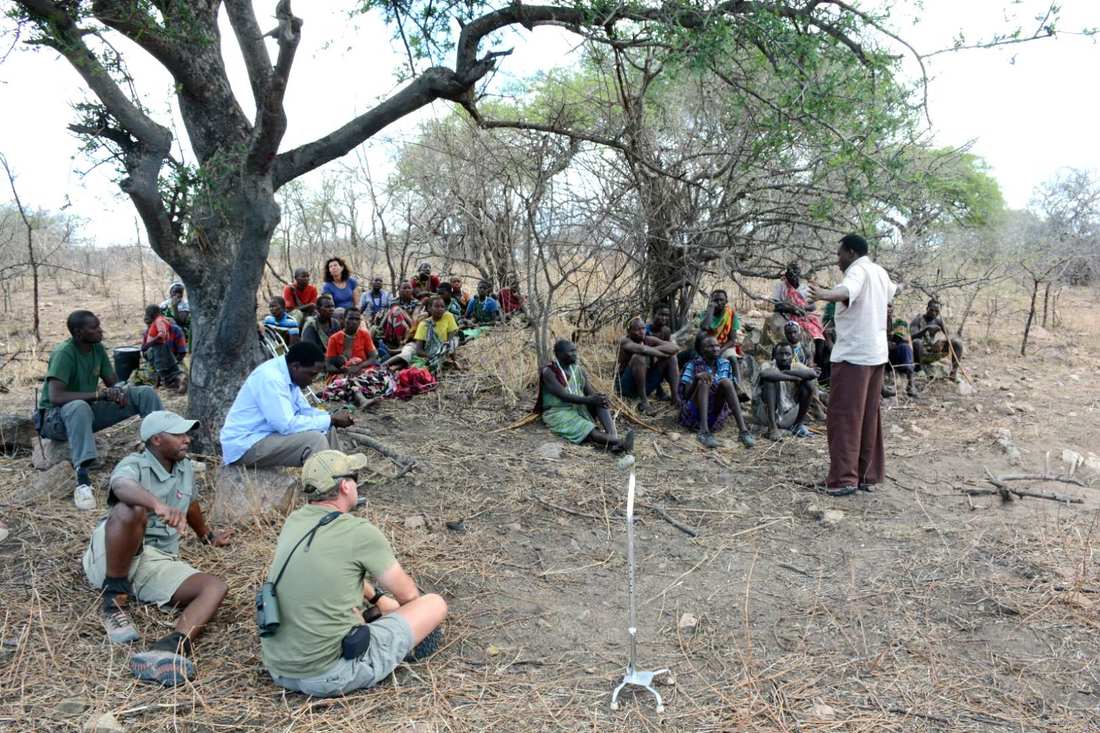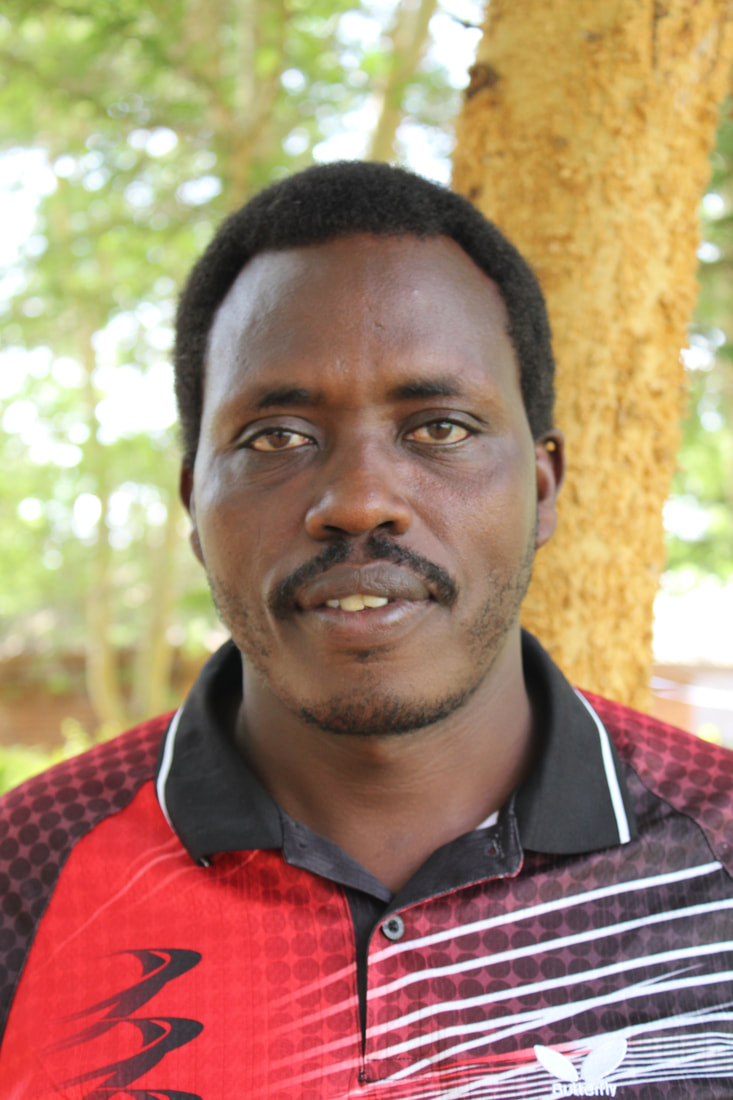|
We are driving down a dusty road lined with acacia trees on the way to Nakwetikia’s boma. She’s nearing 80 years old but you wouldn’t know it. She’s sharp and inquisitive, and has a phenomenal sense of humor. Earlier in the day she sent an entire group of reporters into hysterics, as she looked a traditional male leader from a nearby village in the eye and sternly warned him not to lie or he’d have another thing coming. While Nakwetikia says she has always had a quick wit and a sharp tongue, the Women’s Rights and Leadership Forum is what helped her find her voice in her community. Ng’abolo Village is one of five villages that form the Makame Wildlife Management Area, an acacia filled woodland comprised of over 4,500km2. These five villages work together to sustainably manage this WMA for the use of humans, cattle and wildlife alike. UCRT has worked in this area for over 4 years supporting improved natural resource management, good governance training as well as mobilizing women to participate in decision making. Nakwetikia is a member of the Women’s Rights and Leadership Forum of Ng’abolo and has been an outspoken advocate for women’s involvement in natural resource management in her village. Today, we are visiting Nkwatikia’s boma to gain a greater understanding of how the Women’s Right and Leadership Forums have helped women like herself adjust to and challenge the pressures from a rapidly growing community and its pressures of traditional pastoralist livelihoods. Nakwetikia has seen a great deal in her eight decades in this village. It’s grown exponentially, from a few families to hundreds, primarily due to migration into the area. The large influx of people has brought with it many challenges including poaching, land grabbing, and illegal farming. It has also caused pastoralists in the area to become more vulnerable to land loss. But, nothing has surprised Nakwetikia as much as the change brought by the Women’s Rights and Leadership Forum. Modeled after traditional Maasai leadership institutions, the WRLF is comprised of 24 female representatives from a village. These women represent the interests of all women in their village, making decisions, advocating on their behalf, and supporting each other. Before formalising their group with support from UCRT four years ago, women used to meet in secret often while they were out collecting water or firewood. Nakwetikia shared: “As more people moved to the area, pressures on the land grew. Cattle were taken elsewhere to graze, water become more difficult to find and there was less land available for traditional uses. We women realised these pressures and would discuss them often but we had no way to stop it. With the WRLF, we can now openly discuss issues and help create solutions for the greater community.” When the WRLF was formed, women received training on their rights to own land, property and the rights to their children in addition to trainings around leadership, communication and good governance. Beyond providing a formal space for women to meet and be part of the decision making progress in the village, the WRLF has had another important and somewhat initially unexpected role in the village: protecting the land and natural resources. UCRT learned early on that women in Ng’abolo village possessed a wealth of knowledge when it came to particular grazing areas, migration routes and livestock water points as well as the resources in the area and their uses – more so then the men. UCRT realised the WRLF, in addition to empowering women, could be crucial in protecting and reinforcing Village Land Use Plans, Natural Resource Management Plans, and Wildlife Management Areas. These days, the women of Ng’abolo are able to meet out in the open and have become a powerful force of positive change in their community. Paine Makko, who helped start UCRT’s Gender Programme remarked: “As the WRLF in Ng’abolo has strengthened, they’ve started to demand accountable governance, and secure participatory decision making, especially in respect to land management. As the WRLF has gained momentum, we’ve witnessed a decrease in poaching, land encroachment, and charcoal burning in the area. In another five years, we can’t wait to see what the WRLF accomplish.” As Ng’abolo village’s population increases and with it the pressures on resources and land grow; adaptive solutions are needed that are both peaceful and sustainable. While these are community-wide issues, their success very much depends on the involvement of pastoralist women. WRLF have been catalysis of change in their communities and are bringing real solutions to the table. Learn more about our gender programming here.
1 Comment
Dismas has developed countless Land Use Plans, resolved many conflicts, and ensured continued sustainability of our programmes in some of the most difficult and politicised areas we work. The past 16 years he has worked with the Hadza and Datoga tribes in Yaeda valley and has celebrated many successes with those communities during that time. We sat down with Dismas to ask him a few questions about his work and achievements over the years. What brings you happiness in your work? “When we achieve what we set out to do, when we meet the needs and expectations of the communities we work with, that’s when I’m happy. On the flip side, it really disturbs me if we fail, letting down those we work with. It also brings me joy when other people are happy and have what they need to be comfortable- when I see the Hadza are enjoying their livelihoods, I’m happy. When I’m in the field, especially in Yaeda. When I sit in the community and see this community gaining their rights- that brings me a lot of joy.” What achievement are you most proud of? “Creating the first group CCRO’s (Certificates of Customary Rights of Occupancy) in Tanzania. We had been using Land Use Plans in Yaeda for a number of years but certain individuals in the community were not respecting these plans. The area that had been set-aside for the Hadza was changed and we realised that the Land Use Plans on their own were not enough. The Hadza needed some sort of legal protection. We sat with the village land use officer and determined that we needed communal ownership, not individual use and that is how the idea of CCRO’s was born. After securing the ownership for the Hadza we moved to secure rights for the nearby pastoralist Datoga. It’s amazing to see how much this idea has grown.” How has UCRT grown and changed in the last 20 years? “I remember a time when UCRT staff had to borrow a friend’s car or go to sites by foot. In some ways [traveling by foot] might have helped us in our work. We are most effective when we stay with the communities, learn their challenges and problems and then they begin to trust you.”  Dimas facilitating a training with the Hadza in Sungu. Dimas facilitating a training with the Hadza in Sungu. For pastoralists and hunter-gatherers, communal land is essential to preserving their livelihoods. UCRT has found that Certificates of Customary Rights of Occupancy support collective and responsible land use and are a cost effective way to ensure entire communities to legally obtain land security under the Village Land Act. We recently celebrated the handing over of CCRO’s for five villages in Monduli District – the largest ceremony in Monduli to date. Monduli is home to an estimated 158,9291 people, primarily traditional Maasai pastoralists. A total of 34,701 hectares of land was secured through these CCRO’s and an additional 5,850 ha through a Village Land Certificate for Mungere. The hand over ceremony has been years in the making. For a village to receive their Certificate of Customary Rights of Occupancy they must participate in a series of trainings around natural resource management, good governance, communication, leadership, financial management as well as developing tools like grazing calendars and land use plans to help them sustainably manage their land once it’s secured. This particular handing over ceremony drew quite a crowd, with several hundred community members, partners and government officials in attendance. The villages of Esilalei, Mswakini Chini, Oltukai, Mungere, and Selela all received CCRO’s. The village of Mungere also received its Certificate of Village Land after demarcating village boundaries and developing a land use plan. In addition to village representatives, attendees of the hand over ceremony included representatives from the land commissioner, District Commissioner, MP, District Executive Director, Head of departments of the District, Land and Livestock Community Development officers, members of the media, and implementation partners. A special thank you to Trias, The Nature Conservancy, and Wildlife Conservation Society for funding this initiative. |
Archives
March 2019
Categories |

 RSS Feed
RSS Feed
